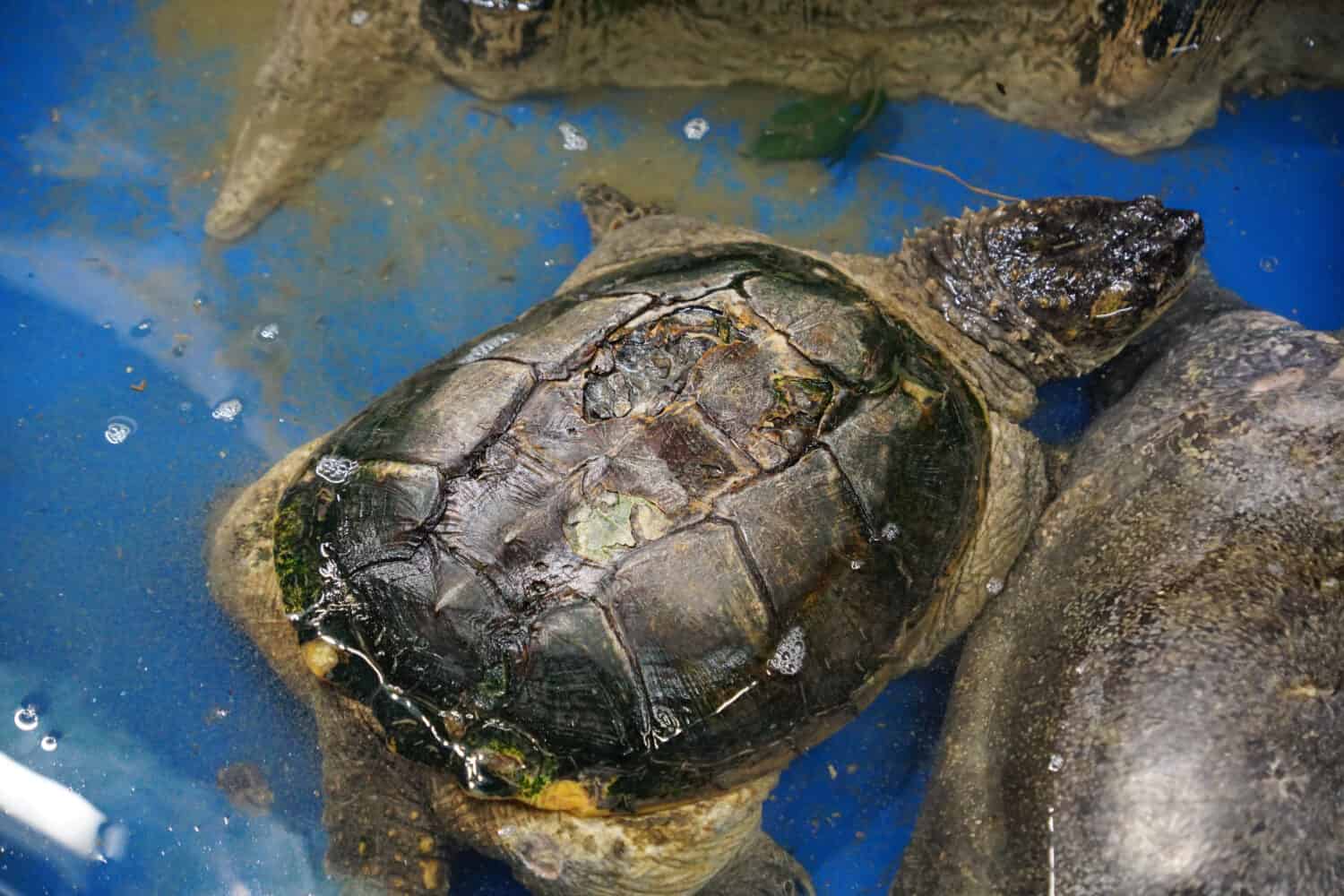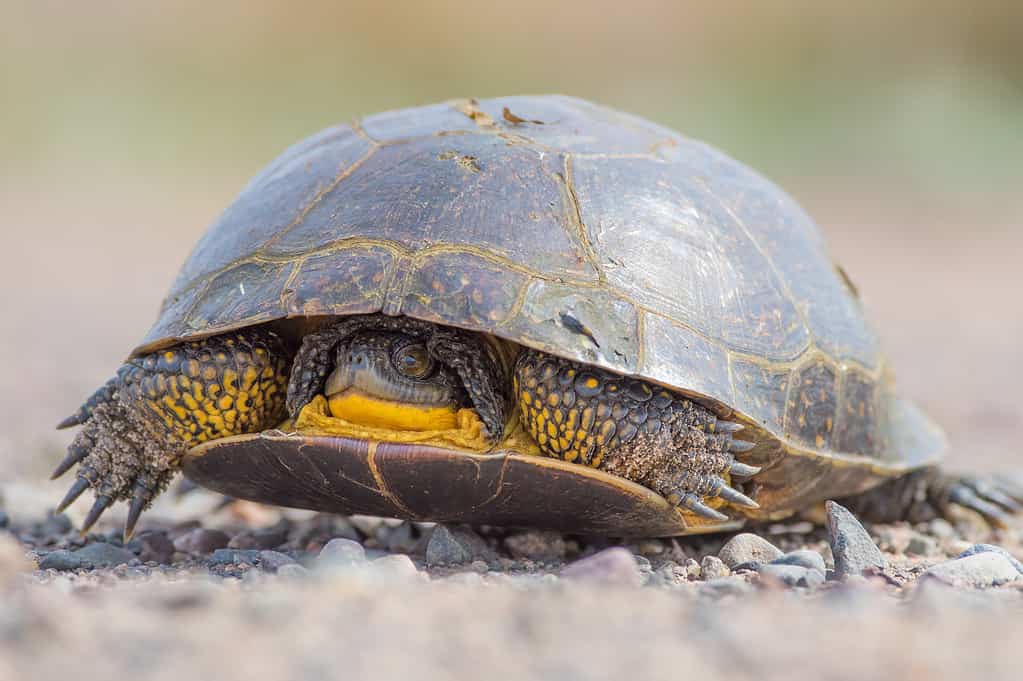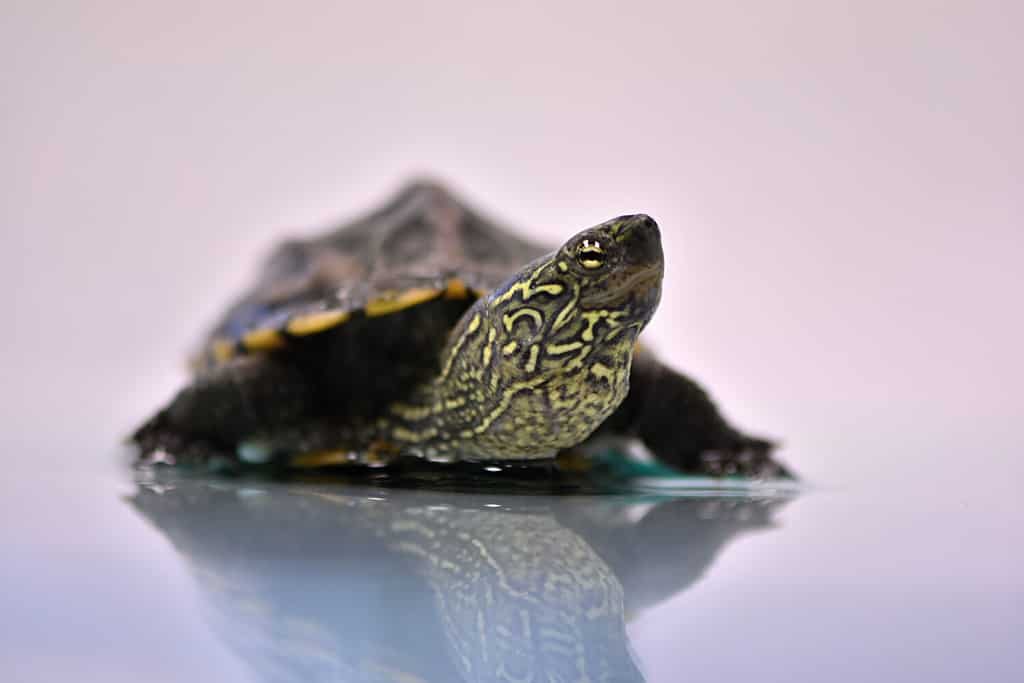Turtles are some of the most unique, yet well-loved pets among families in the United States. Whether it’s their tough shell, their slow speed, or their surprisingly apparent personalities, everyone has a unique reason for why they may love turtles.
Unfortunately, caring for turtles can be an especially tough challenge. Although they are a low-maintenance pet, they do have some specific requirements, such as nutrition and cleanliness. Cleanliness is an extremely important point of care that turtles require. Without proper tank cleaning and body hygiene, turtles can easily develop a variety of conditions. One very common turtle condition is called turtle shell rot. It is an especially rough illness that can cause a slew of troubles for your beloved pet.
What Causes Turtle Shell Rot?

Dirty water is a major cause of shell rot!
©Mudbug Photography/iStock via Getty Images
Turtle shell rot is an “umbrella term” for a slew of related illnesses that shelled animals can develop. It is characterized by the growth and colonization of some pathogen (fungi, bacteria, etc.) on or in the turtle’s shell. Unfortunately, the growth of these nasty things on your turtle’s shell can cause it to rot away.
In many cases, the rot forms from some form of dirty water or unkempt enclosure. Making sure that your enclosure is clean and tidy is a great first step in preventing rot.
Turtle shell rot can develop both on the top side of the shell and the underside. This can make it hard to spot. As mentioned, there are a few main things that can cause shell rot, however many start with some sort of injury or uncleanliness on your turtle’s shell.
Shell rot is especially associated with turtles that spend a lot of time in water. For instance, common pet turtles such as box turtles, which require at least some water, can be threatened by rot. Aquatic conditions tend to provide pathogens with the perfect mixture of resources to grow rapidly and cause rot.
Let’s take a look at some of the most common symptoms and causes of turtle shell rot!
What Does Turtle Shell Look Like – 4 Common Symptoms
One difficulty with turtle shell rot is initial identification. As mentioned, the various types of shell rot can all be caused by different things. In turn, each cause may manifest in different ways.
Cracks in the Shell

Damaged shells can create open avenues for bacteria and fungi to take hold.
©wk1003mike/Shutterstock.com
One big sign that your turtle may have shell rot is if it has cracks in the shell. At the end of the day, shell rot is primarily caused by the colonization and growth of some sort of pathogen, such as bacteria, fungi, or even macroparasites.
Turtle shells act like how skin acts for humans. They essentially create a barrier that is meant to protect against physical and biological attacks. Just like our skin, if their shell takes on some sort of damage, for instance in the form of a cut, it can make them more susceptible to diseases.
Most cases of shell rot are caused by damaged shells, primarily because it is a perfect breeding ground for bacteria. Even if your turtle isn’t actively experiencing shell rot, it is a good idea to check it out if you see any damage on the shell.
Deformed or Soft Shell
Another tell-tale sign of shell rot is a deformed shell or a shell that has lost its structural integrity. The disease essentially eats away at the shell, making large spots of discoloration and deformation. Again, each case of rot may look different, but many people find that shell rot appears in splotches of yellowing or browning shell.
Likewise, the rot can also degrade the structure of the shell itself, which can cause it to become soft or even semi-hollow.
Rotting Scent
Scent is another huge indicator of turtle shell rot. The growth of bacteria in tandem with the physical rotting of the shell can create a slew of scents, all of which aren’t usually pleasant. Depending on the severity of the shell rot, this scent can range anywhere from light and lingering, to strong and pungent.
Generally, the stronger the scent, the more the rot has likely progressed. If you find that your turtle or its enclosure may be smelling even the tiniest bit off, it could be a wise idea to have it looked at!
Discharge
In very severe cases of shell rot, you may see some form of discharge leaking from your turtle’s shell. Discharge usually looks like some form of liquid or paste that is leaking from the surface, or from inside the shell. Even if your turtle’s shell appears to be 100% intact, it can still create discharge.
Discharge is an especially important indicator of shell rot that forms from the inside of your turtle’s shell. It may often be one of the only indicators that something is affecting the health of your turtle.
How to Treat Turtle Shell Rot at Home

Since rot is formed by the growth of pathogens, treatment may be a long and repetitive process.
©BobGrif/iStock via Getty Images
Don’t be daunted if your beloved pet has developed shell rot, there are some easy ways to treat it at home. Additionally, there are also some things you should think about in terms of preventative care so that your turtle will have decreased chances of developing shell rot in the future!
Repeated Soaking
Many sources agree that soaking is an effective method for starting the process of removing turtle shell rot. To do this, simply make a shallow bath of slightly warm water that is comfortable enough for your turtle to sit in. After the bath is created, you can allow your turtle to soak for a few minutes, allowing the water to soak and loosen any bits attached or falling from its shell.
With the soaking, you can also use a soft-bristled toothbrush to brush away any debris or dirt that may be stuck to the shell. If there are extra stuck-on bits, you may also want to use some sort of flexible tool to remove them, such as a credit card. Never use a knife against the shell of your turtle!
After the soak is completed, dry your turtle thoroughly. As with any bath, water may be stuck on even after towel-drying. If that is the case, you should place your turtle in a dry location where the rest of the water can quickly evaporate!
Let Your Turtle Catch Some Sun!
After your turtle has taken a well-deserved bath, you should let it get some sunlight. UV radiation is important for turtles for a variety of reasons. Most importantly, they need it to maintain metabolic capacity! Additionally, radiation can also help clear up external shell-rot issues, especially if they are fungal-related.
If you aren’t in a sunny place, you can also use some sort of UV light bulb to get the same effect!
Use a Topical Antibiotic Agent

Using an antibiotic cream is likely the best solution for getting rid of turtle shell rot.
©Marek Velechovsky/Shutterstock.com
One last at-home treatment is using an antibiotic agent of some type. There are many different types that you can use, such as silver sulfadiazine. Depending on the source of your shell rot, you may want to use something more specific like an antifungal.
In the past, some people have recommended disinfecting with products such as hydrogen peroxide. Although those may work against the live pathogens in the shell, they can also inhibit the healing process.
See a Veterinary Professional
One last solution is to simply visit a veterinary professional. Sometimes, the problems our pets experience are simply too much for us to handle on our own. Seeking help, or even advice from a veterinarian can greatly aid in the process of helping your pet feel happy and healthy again.
Additionally, if your turtle’s shell rot is truly a large problem, veterinarians can prescribe strong antibacterial solutions that work fast!
The photo featured at the top of this post is © Joseph Alexander Cruz/Shutterstock.com
Thank you for reading! Have some feedback for us? Contact the AZ Animals editorial team.







